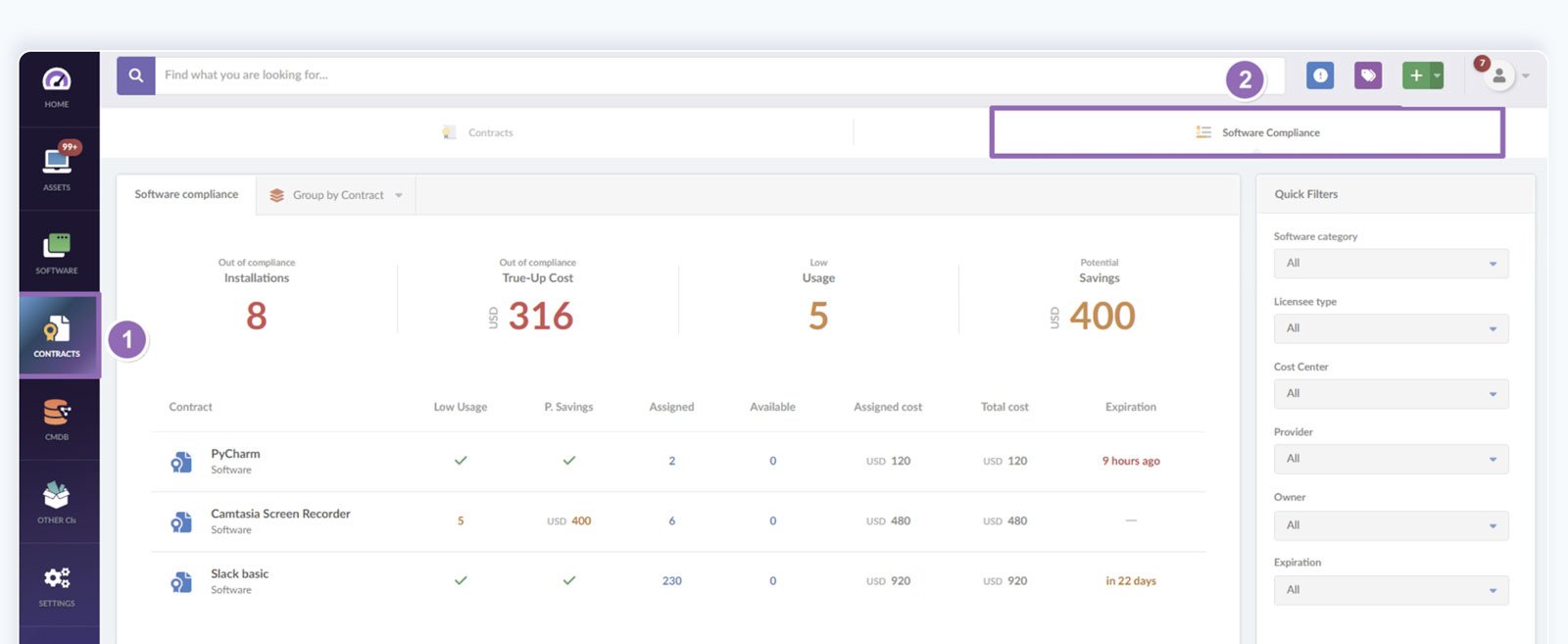Compliance Management is the practice that helps organizations comply with their legal, security, and regulatory requirements. It can support effective Risk Management and improve operational efficiency, reputation, and trust.
In this article we will investigate the main activities involved in this practice, explore the implementation process and some challenges to look out for in the way. To finish off, we will see how InvGate Asset Management can help you streamline some key activities in this process.
Let's get started!
What is Compliance Management?
Compliance Management manages an organization's responsibilities and ensures that the appropriate legal and regulatory requirements are met. It is the set of practices that ensures compliance responsibilities are identified and addressed appropriately.
In addition, it sets out compliance roles and responsibilities so that everyone knows what is expected of them. Its main objective is to manage all compliance activities cohesively and proactively.
IT Compliance Management
IT Compliance Management ensures that an organization's IT systems, practices, and policies align with the overall business compliance framework. It focuses on the IT aspects of compliance that are closely related to Software Asset Management and Software License Management. This is particularly important for information security, data protection, cyber resilience, and IT service delivery.
Risk Management vs. Compliance
Many people get confused about the difference between compliance and Risk Management, so let's take a moment to look at the differences between the two:
- Compliance Management: It is a very targeted set of practices ensuring an organization adheres to all relevant laws, regulations, industry standards, and internal policies. The main objective of Compliance Management is to avoid legal penalties, regulatory fines, and reputational damage by ensuring that the organization operates within the boundaries set by external authorities.
- Risk Management: It is a broader concept that is responsible for the identification, assessment, prioritization, and management of risks. While compliance is one aspect of it , Risk Management goes beyond compliance to address a wide range of risks, including operational, financial, strategic, and reputational risks.
Security vs. Compliance
Let's also take a moment to explore the differences between security and Compliance Management.
- Compliance Management: It primarily focuses on aligning an organization's practices, policies, and procedures with relevant regulatory requirements, industry standards, and internal guidelines. Part of this will include IT security tasks, but its main focus is to protect the organization from legal or reputational exposure by meeting all legal and regulatory requirements.
- IT Security Management: It protects digital assets and information from unauthorized access, vulnerabilities, and threats. It encompasses the implementation of security controls, risk assessments, and security incident response plans to protect against cyber-attacks and data loss. While Compliance Management often requires adherence to security-related regulations, IT Security Management is a broader discipline that focuses on continuously protecting an organization's infrastructure and data.
Why is IT Compliance Management important?
IT Compliance Management is important because it keeps you and everyone in your organization honest. This means, not only does it keep you out of trouble, but it also protects your organization, its data, and your people.
IT compliance is important for the following reasons:
- Ensuring legal and regulatory requirements are met - Many industries must adhere to strict regulatory and legal controls, and non-compliance can result in severe consequences, including fines, sanctions, legal action, and reputational damage. This practice helps organizations navigate complex regulatory landscapes and avoid costly penalties.
- Protecting your data - Another key activity in Compliance Management is data and intellectual property protection. It ensures that data is protected, reducing the risk of breaches and the associated financial, legal, and reputational damage.
- Enhancing cyber resilience - IT compliance activities also complement cyber resilience by providing a structured framework and a set of practices that help establish a strong foundation for cybersecurity.
- Strengthening Risk Management practices - As we mentioned, effective IT Compliance Management identifies and mitigates risks associated with IT service delivery. By proactively addressing vulnerabilities and threats in a structured manner, organizations reduce the likelihood of security incidents and service disruption.
- Improving customer experience - In recent years, there have been many horror stories about data loss and security breaches that can cause anxiety for customers and stakeholders. Demonstrating compliance with data protection and security standards builds trust and confidence among customers, making them feel more comfortable engaging with your services.
- Gaining competitive advantage - A solid compliance practice can provide a competitive edge, and a commitment to IT compliance best practices can enhance your reputation in the marketplace. Organizations that meet or exceed compliance requirements may gain access to new markets and opportunities that require adherence to specific regulations, giving them a competitive advantage over non-compliant competitors.
- Strengthening supplier and partner relationships - Compliance Management extends to third-party vendors and partners involved in IT service operations. It's important to ensure that vendor compliance practices align with your organization's requirements to mitigate risk.
Nine challenges of IT Compliance Management
Although IT Compliance offers a wide range of benefits, it also brings together a range of activities that can present difficulties to organizations when implementing them. Some common challenges to consider include:
- Lack of buy-in - It’s important to have support from senior management and other team members. For this, ask yourself this question – if compliance is expensive, how much will the impact of non-compliance affect you?
- Ensuring third-party vendors and partners agree - Most organizations rely on third-party suppliers for IT services. It is important to ensure that our suppliers' vendors also meet compliance requirements and do not introduce additional risks to the service ecosystem. This should be captured in any Service Level Agreements (SLAs) and underpinning contracts so that the compliance responsibilities of both parties are captured, agreed on, and documented at a contractual level.
- Resource constraints - Maintaining compliance can be resource-intensive, requiring dedicated staff, technology, and processes.
- Changing requirements - The regulatory landscape constantly changes as new regulations are brought about and existing ones are updated to manage evolving cyber threats. So, IT compliance often involves navigating a complex series of industry-specific regulations, international standards, and laws. Staying current with these requirements and ensuring compliance across multiple jurisdictions can be difficult without the right support.
- Complex IT infrastructures - As IT evolves, so does technical complexity. Compliance Management must consider the challenges introduced by the cloud, remote working, and the Internet of Things.
- Organizational silos - It's easy for people to get sidetracked and work in their little bubbles or silos. This makes it more difficult to apply compliance processes consistently and can cause the potential for errors and re-work.
- Cyber security threats. Cyber attacks are almost continuously present in our news cycles; as we said, we've all seen horror stories, so it's important to take the right action now so we don't become a cautionary tale in the future. There will always be people with malicious intentions, so we must stay ahead of them by constantly reviewing our security protocols and proactively addressing new threats.
The Compliance Management process
How you approach Compliance Management will depend on several factors, including the industry your business is in, the standards you have to meet, available resources, and customer requirements. That being said, there are core elements to the process, which include:
- Set your objectives: Compliance Management must clearly understand an organization's regulatory compliance responsibilities to be effective. Before you do anything else, work with your legal, governance, and risk teams to identify all applicable regulations and standards you need to meet at an organizational level.
- Design compliance roles and responsibilities: It can be useful to codify them in a RACI chart so everyone knows what they are responsible for and nothing gets lost or forgotten about.
- Create a baseline: Carry out a thorough gap analysis and risk assessment. This will help you understand your compliance landscape, identify gaps in your process and priorities, and how to address them.
- Create processes and procedures: This will encourage your compliance workflows to be followed consistently, and you can demonstrate to auditors, regulators, and business stakeholders that your organization is meeting its compliance obligations.
- Use a Compliance Management System: A CMS offers a structured approach for reviewing and updating policies, communicating with employees, maintaining audit trails, and proving compliance with industry standards and regulations.
- Train your people: It sounds simple, but it's easy to forget that everyone in your organization is responsible for compliance, so ensure they have access to the appropriate training.
- Automate where possible: Using automation can make routine tasks more efficient, improve cohesiveness, and reduce the potential for human error, which frees up support teams to focus on other aspects of Compliance Management.
- Have a plan for audits: When preparing for external audits, the best thing you can do is run an internal audit first to correct any potential issues and create a plan to improve in the case of any major findings. Key activities will include.
- Defining audit schedule and procedures
- Identifying who will perform the audits.
- Performing audits on the established baselines
- Generating audit reports
- Managing exceptions
- Documenting lessons learned
- Patch and check for vulnerabilities often: The threat landscape is continually changing, so it's important to scan your environment for vulnerabilities and patch them regularly. Build Patch Management into your Change Enablement practices so that patches can be quickly tested and deployed to your live environment to protect it from external threats.
- Continual improvement. The compliance landscape is constantly evolving, so we need to build continual improvement activities into our practices to ensure they continue to support the needs of the business.
Using InvGate Asset Management to enhance your IT Compliance Management

As we have seen, Compliance Management involves a wide range of different activities. Particularly for IT, a big part of this practice involves Software Asset Management that ensures licenses are correctly tracked, and unnecessary fines, legal penalties, and downtime are avoided.
To streamline this process, InvGate Asset Management’s Software Compliance feature leverages the information from your logged contracts and crosses it with the reported software usage. Then, you can manage and filter this data in the way you find most convenient to monitor out of compliance installations and other important aspects such as usage, costs, and expiration dates.
In conclusion
Done well, Compliance Management protects your organization, its people, and their data by helping you to meet legal, regulatory, and compliance obligations. Benefits include a more transparent operating environment, effective Risk Management, and improved customer confidence.
Because it attacks many fronts, this practice involves many processes and to implement it successfully it’s important to plan the process accordingly and prioritize according to your company's needs and goals. Specifically for IT compliance, the focus lies on effective License and Contract Management.
If you want to explore a bit more what InvGate Asset Management can do both for your compliance requirements and your ITAM practices in general, check out our 30 day free trial!
Frequently Asked Questions
What is the function of Compliance Management?
Compliance Management is the practice used to help organizations meet their legal, regulatory, and compliance obligations.
What are the five areas of compliance?
The five areas of compliance are legal and regulatory compliance, financial compliance, data protection and privacy compliance, IT compliance, and ethical and IT governance compliance.
What is an example of Compliance Management?
An example of Compliance Management would be ensuring an audit trail exists to capture any access activity around sensitive data.
What is a compliance manager?
A compliance manager is the person who is responsible for the Compliance Management practice.
What is a Compliance Management system?
A Compliance Management system or CMS is a structured and systematic approach organizations use to manage and monitor compliance with applicable laws, regulations, standards, and internal policies. The primary goal of it is to ensure that the organization conducts its activities in a compliant and ethical manner while minimizing risks associated with non-compliance.















